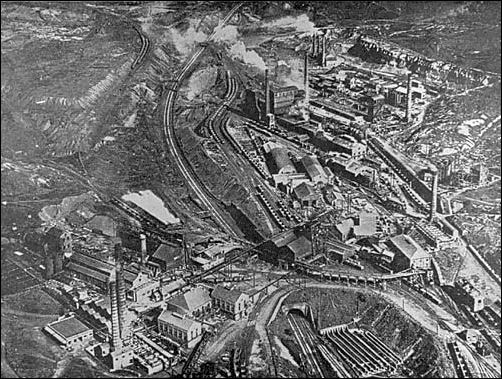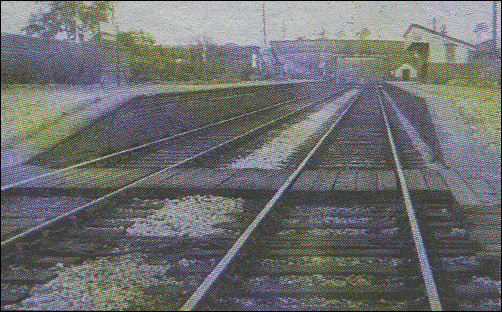|
Goldenhill
on the Potteries Loop Line
  
click the
"contents" button to get back to the main index
next: Pitts Hill on the Loop Line
previous: Kidsgrove
on the Loop Line
|
Historian Fred Hughes
writes....
The thing you notice as you leave Kidsgrove travelling south along the
former Loop Line is the silence and peace, disturbed only by the flow of
numerous watercourses pouring downhill to find their way by a series of
streams into the Fowlea Valley and then to the Trent.
“Most Trent tributaries rise around Mow Cop and Biddulph Moor,” says
historian Steve Birks. “The land buckled as a consequence of the
retreating Ice Age and the water finds its way to the lowest level. Along
the Loop Line track you can actually see it change course. It’s like a
mini continental divide. It’s noticeable as the line climbs to its summit
approaching Newchapel and Goldenhill where the brook races in one
direction to Kidsgrove. A few steps past the summit the same watercourse
suddenly changes direction and follows the rail track south towards the
Clanway Valley to feed the Scotia Brook.”
|
Time has altered the landscape spectacularly. And yet industry has played
its part too. Former Loop Line engine driver Paul Nutty stands beside me
near the heart of the once-unsightly Birchenwood mineral complex where
industry tore the environment to shreds. And yet these days, where once
gas retort machines and cooling cylinders pumped pollution across
Newchapel’s pleasant fields, the new Birchenwood housing development and
Country Park lie among reclaimed land where wildlife is returning in
abundance.
“It’s almost impossible to see it now as I remember it back in the 1950’s”
exclaims Paul. “You see everything has changed. The line for a start was
in a deep cutting, and that was a blessing because you couldn’t see the
ground level of Brichenwood. But you knew it was there because of the
stink, the smoke and the noise, even above the engine’s roar. The only
thing you could see was the high ‘rolly’, a mountainous slag tip. My
grandfather helped build the tip with a shovel. There were no mechanical
earthmovers then."

Birchenwood
Colliery site, 1891-1932
Almost all the coal from this group of pits was used for coke and other
by-products.
the loop
line running top to bottom in the centre of the picture can be seen
running through the Birchenwood Tunnel
photo: ©
Staffordshire Past Track
|
I’m interested to know how Paul became to ride the engine platforms of the
Loop Line.
“I started work for North Staffordshire Railways as a cleaner on the
first link,” explains Paul.
“A link was a development level and there were three. Cleaning and
maintenance was the first link where you were a general dogsbody. In
fact you never left the shed. I was 18 when they let me go firing.
This was the start of the second link although you were still called
‘past cleaner’. There was no training; you learned by watching. An
inspector tested you and once you passed you began as a fireman, but
only as a stand-in at first. After this you became a driver, although
you were referred to as a ‘past fireman’ until you became fully
qualified.
Then you were tested on driving freight wagons before driving passenger
trains. The process was geared to seniority rather than experience, and
you often found men coming from other regions to drive local trains just
because they had more service in than you.
Training relied on what we called ‘road learning’ and ‘brake-pinning’
which was about speed and weight control. Then you had to familiarise
yourself with the routes and the different signals.”
I’m troubled by this un-academic process. “You mean to say that if you had
your time in as a driver you could drive an express to London?” I gasp.
“Yes, but you will have had training on the Coronation Class, as the
long journey engines were called,” responds Paul. “But ask yourself the
question – as an experienced driver of a 1000cc Austin Seven – would
that restrict you from driving a 24 horse-powered Rolls Royce.”
This doubtful comparison impressed me with its logic.
“One restriction when driving a steam engine was that you were barred if
you wore glasses,” says Paul.
I puzzle at such discrimination.
“You’d be causing great danger if your glasses steamed up or became misted
because of the smoke from the chimney,” he explains. “Wearing glasses was
risky. Naturally after diesel and electrification the driver didn’t need a
fireman; he was in an enclosed cabin so wearing glasses was ok.”

Looking back along the
route of the loop line towards Kidsgrove
The remains of the station platform can be seen on the left

Goldenhill Station in the 1950's
photo: The Sentinel Newspaper
As the 1 in 40 gradient levels out, the landmark green spire of
Newchapel becomes visible on the skyline. The rail cutting opens into
fields once filled with crops and livestock, now with housing estates.
Here the line passes under Colclough Lane and pulls up at Goldenhill
Station where the former platform lies buried but can still be made out.
And despite the housing developments Goldenhill Station is idyllically
peaceful. It’s like a scene from the Railway Children without the trains,
the lines and the people.
“It’s a good half mile out of Goldenhill,” explains Steve. “Passengers
would have a lengthy journey along a lonely lane to get here.”
Paul remarks, “Country stations so far from the nearest town would have
the word street attached to it. This would be known as Goldenhill Street.
Goldenhill was always quiet.”
It is a remark that our newest companion Graham Cartwright disputes. But
we’ll let him tell his story next week as we aim for Pittshill.
 more on Birchenwood on the loop line
more on Birchenwood on the loop line
 more on Goldenhill on the loop line
more on Goldenhill on the loop line
|
![]()
![]()
![]()